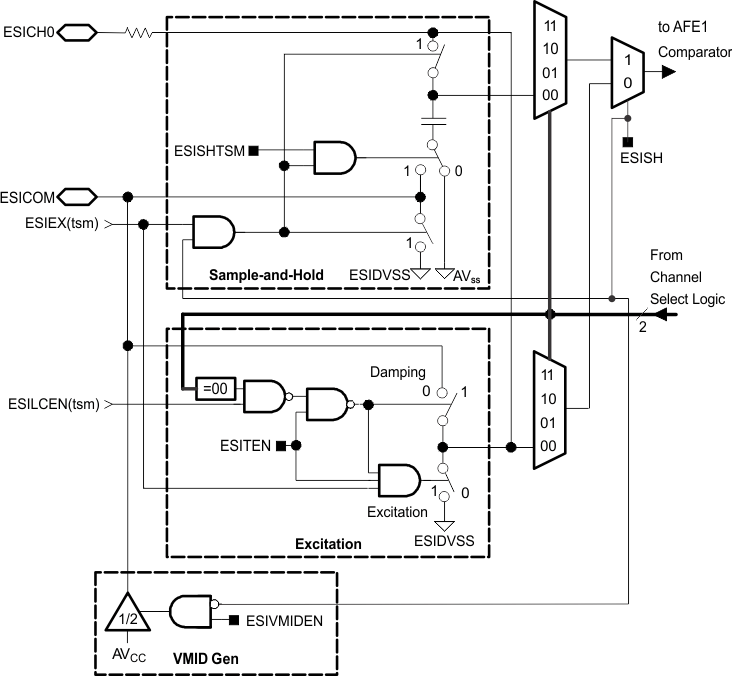SLAU367P October 2012 – April 2020 MSP430FR5041 , MSP430FR5043 , MSP430FR50431 , MSP430FR5847 , MSP430FR58471 , MSP430FR5848 , MSP430FR5849 , MSP430FR5857 , MSP430FR5858 , MSP430FR5859 , MSP430FR5867 , MSP430FR58671 , MSP430FR5868 , MSP430FR5869 , MSP430FR5870 , MSP430FR5872 , MSP430FR58721 , MSP430FR5887 , MSP430FR5888 , MSP430FR5889 , MSP430FR58891 , MSP430FR5922 , MSP430FR59221 , MSP430FR5947 , MSP430FR59471 , MSP430FR5948 , MSP430FR5949 , MSP430FR5957 , MSP430FR5958 , MSP430FR5959 , MSP430FR5962 , MSP430FR5964 , MSP430FR5967 , MSP430FR5968 , MSP430FR5969 , MSP430FR5969-SP , MSP430FR59691 , MSP430FR5970 , MSP430FR5972 , MSP430FR59721 , MSP430FR5986 , MSP430FR5987 , MSP430FR5988 , MSP430FR5989 , MSP430FR5989-EP , MSP430FR59891 , MSP430FR5992 , MSP430FR5994 , MSP430FR59941 , MSP430FR6005 , MSP430FR6007 , MSP430FR6035 , MSP430FR6037 , MSP430FR60371 , MSP430FR6041 , MSP430FR6043 , MSP430FR60431 , MSP430FR6045 , MSP430FR6047 , MSP430FR60471 , MSP430FR6820 , MSP430FR6822 , MSP430FR68221 , MSP430FR6870 , MSP430FR6872 , MSP430FR68721 , MSP430FR6877 , MSP430FR6879 , MSP430FR68791 , MSP430FR6887 , MSP430FR6888 , MSP430FR6889 , MSP430FR68891 , MSP430FR6920 , MSP430FR6922 , MSP430FR69221 , MSP430FR6927 , MSP430FR69271 , MSP430FR6928 , MSP430FR6970 , MSP430FR6972 , MSP430FR69721 , MSP430FR6977 , MSP430FR6979 , MSP430FR69791 , MSP430FR6987 , MSP430FR6988 , MSP430FR6989 , MSP430FR69891
37.2.1.1 Excitation
The excitation circuitry is used to excite the LC sensors or to power the resistor dividers. The excitation circuitry is shown in Figure 37-4 for one LC sensor connected. When the ESITEN bit is set and the ESISH bit is cleared, the excitation circuitry is enabled and the sample-and-hold circuitry is disabled.
When the ESIEX(tsm) signal from the timing state machine is high, the ESICHx input of the selected channel is connected to ground (ESIDVSS pin) and the ESICOM input is connected to the mid-voltage generator to excite the sensor. The ESILCEN(tsm) signal must be high for excitation. While one channel is excited and measured, all other channels are automatically disabled. Only the selected channel is excited and measured.
The excitation period should be long enough to overload the LC sensor slightly. After excitation the ESICHx input is released from ground when ESIEX(tsm) = 0, and the LC sensor can oscillate freely. The oscillations swing above the positive supply but are clipped by the protection diode to the positive supply voltage plus one diode drop. This gives consistent maximum oscillation amplitude.
At the end of the measurement, the sensor should be damped by setting ESILCEN(tsm) = 0 to remove any residual energy before the next measurement.
 Figure 37-4 Excitation and Sample-And-Hold Circuitry
Figure 37-4 Excitation and Sample-And-Hold Circuitry